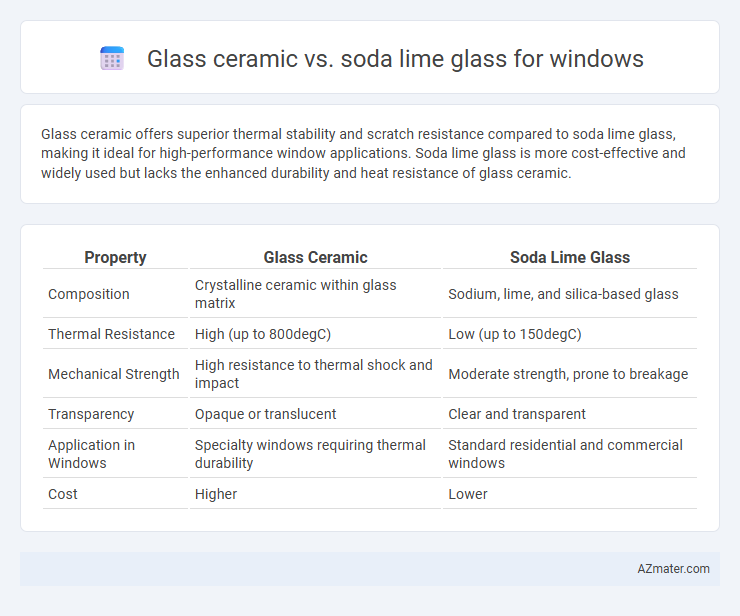Glass ceramic offers superior thermal stability and scratch resistance compared to soda lime glass, making it ideal for high-performance window applications. Soda lime glass is more cost-effective and widely used but lacks the enhanced durability and heat resistance of glass ceramic.
Table of Comparison
| Property | Glass Ceramic | Soda Lime Glass |
|---|---|---|
| Composition | Crystalline ceramic within glass matrix | Sodium, lime, and silica-based glass |
| Thermal Resistance | High (up to 800degC) | Low (up to 150degC) |
| Mechanical Strength | High resistance to thermal shock and impact | Moderate strength, prone to breakage |
| Transparency | Opaque or translucent | Clear and transparent |
| Application in Windows | Specialty windows requiring thermal durability | Standard residential and commercial windows |
| Cost | Higher | Lower |
Introduction to Window Glass Materials
Glass ceramic and soda lime glass serve distinct roles in window applications due to their differing thermal and mechanical properties. Glass ceramic offers superior thermal resistance and dimensional stability, making it ideal for environments with fluctuating temperatures. Soda lime glass, the most common window glass, provides affordability and ease of manufacture but has lower thermal resilience compared to glass ceramic.
Overview of Glass Ceramic
Glass ceramic for windows offers superior thermal resistance and structural stability compared to soda lime glass, making it ideal for environments with extreme temperature fluctuations. Its unique microstructure provides enhanced durability and minimal thermal expansion, reducing the risk of cracks and breakage. This material also delivers better energy efficiency and longevity, outperforming conventional soda lime glass in insulating properties.
Overview of Soda Lime Glass
Soda lime glass, the most commonly used glass type for windows, consists primarily of silica, soda, and lime, offering cost-effectiveness and ease of production. Its relatively lower thermal resistance and moderate durability make it suitable for standard window applications but less ideal for high-temperature or impact-prone environments. In contrast, glass ceramics provide superior thermal shock resistance and mechanical strength, but at a higher cost and complexity in manufacturing.
Key Physical Properties Comparison
Glass ceramic exhibits superior thermal resistance and minimal thermal expansion compared to soda lime glass, making it less prone to cracking under temperature fluctuations. Soda lime glass has lower hardness and is more susceptible to scratches and impact damage, whereas glass ceramic offers higher mechanical strength and durability. Transparency levels are comparable, but glass ceramic often provides enhanced thermal insulation, improving energy efficiency in window applications.
Thermal and Chemical Resistance
Glass ceramic offers superior thermal resistance compared to soda lime glass, withstanding rapid temperature changes up to 700degC without cracking. Its chemical stability is notably higher, resisting corrosion from harsh chemicals and environmental pollutants that commonly degrade soda lime glass. Soda lime glass, while cost-effective, is more prone to thermal stress and chemical weathering, making glass ceramic the preferred choice for high-performance window applications requiring durability and longevity.
Durability and Longevity
Glass ceramic offers superior durability and longevity compared to soda lime glass, owing to its enhanced thermal resistance and high mechanical strength. Soda lime glass, commonly used in windows, is more prone to scratches, thermal stress, and breakage over time. Glass ceramic's resistance to thermal shock and chemical corrosion makes it a longer-lasting choice for high-performance window applications.
Energy Efficiency and Insulation
Glass ceramic offers superior energy efficiency and insulation for windows due to its low thermal conductivity and high resistance to temperature fluctuations, reducing heat transfer and minimizing energy loss. Soda lime glass, while more common and cost-effective, has higher thermal conductivity, resulting in greater heat transfer and less effective insulation. Choosing glass ceramic over soda lime glass can significantly improve building thermal performance and reduce heating and cooling costs.
Aesthetics and Design Flexibility
Glass ceramic offers superior aesthetics and design flexibility for windows due to its ability to withstand high temperatures and rapid temperature changes without cracking, allowing for sleek, modern designs with minimal framing. Soda lime glass, while more cost-effective, is less versatile in design since it is more prone to thermal stress and breakage, limiting its application to standard window shapes and sizes. The high thermal stability and customizable finishes of glass ceramic enhance its appeal in contemporary architectural projects prioritizing both form and function.
Cost and Availability
Glass ceramic offers superior heat resistance and durability but comes at a significantly higher cost compared to soda lime glass. Soda lime glass remains the most widely available and affordable option for window applications due to its mass production and lower manufacturing expenses. The choice between the two largely depends on budget constraints and specific performance requirements for the window.
Choosing the Right Glass for Windows
Glass ceramic offers superior thermal resistance and durability compared to soda lime glass, making it ideal for energy-efficient windows in extreme climates. Soda lime glass, commonly used in residential applications, provides cost-effective transparency but lacks the advanced insulation properties of glass ceramic. Selecting the right window glass depends on balancing factors like budget, thermal performance, and structural strength, with glass ceramic excelling in thermal stability while soda lime glass offers affordability and ease of manufacture.

Infographic: Glass ceramic vs Soda lime glass for Window
 azmater.com
azmater.com